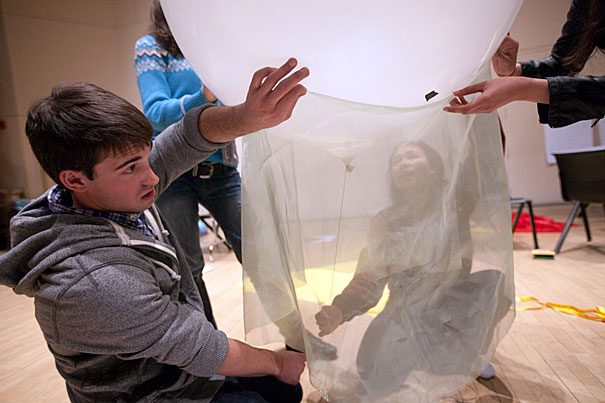
The new President’s January Innovation Fund supports research and projects over winter break. Gary Carlson ’13 (left) and Jia Jia Zhang ’13 work on a prototype of a balloon-supported structure that could be used for lifting and/or shelter in the wake of disasters like last year’s earthquake in Haiti.
Kris Snibbe/Harvard Staff Photographer
Raising the bar on disaster relief
President’s fund helps project work on new kind of shelter
A powerful earthquake hit Haiti on Jan. 12, 2010, devastating a country that was already among the poorest in the world. The catastrophe took more than 200,000 lives and left more than a million people homeless. Now, Harvard undergraduates and faculty from the School of Engineering and Applied Sciences (SEAS) are looking to an old technology for new ways of providing shelter to disaster victims.
“We’re exploring the feasibility of using large balloons to support lightweight tents and to lift and move objects,” said Barry Griffin, a visiting lecturer at SEAS and co-leader of a project to develop a rapid deployment disaster relief shelter. “We want to see if these structures can be used in disaster relief efforts where time is of the essence and short-term shelter is needed.”
The rapid deployment disaster relief shelter project is one of a dozen initiatives funded by the new President’s January Innovation Fund for Faculty. Established last September, the fund supports development of “creative academic or co-curricular experiences” for students during winter break. Other supported programming includes a course on human rights efforts in Ghana, a Harvard-MIT geology field camp, and a trip to Brazil to study public health.
Harvard President Drew Faust said the January Innovation Fund allows the University to offer an important complement to regular course work.
“The activities supported by the January Innovation Fund expand and enrich the overall student experience,” said Faust. “It’s exciting to see faculty take advantage of the time between semesters and create opportunities for students across the University to test new ideas and explore different areas of knowledge.”
Griffin said images of the Haiti earthquake’s aftermath got him thinking of some work he’d done using balloons to move logs in West Coast forests. If a balloon could lift a tree, then why not a tent? Why not debris?
“It occurred to me that we might be able to combine some ideas from balloon logging with some things that Dan Nevius ’11, Julie Xie ’12, and several other students were doing as part of the NASA Student Engineering Design Challenge.”
Nevius, an engineering sciences concentrator with a secondary concentration in astrophysics, was trying to design a tool that could be used to move items on the moon. He and Griffin came up with a system of towers, cables, and winches, with a payload attached in the middle. Change the length of the cables, and the payload moves. To address the problem of disaster relief, they turned their model upside down.
“We thought about hanging a balloon in the middle, instead of a payload,” Nevius said. So instead of moving something in and laying something down, as you would on the moon, you’re picking something up and moving it away. It allows you to deploy a tent from the top or to move debris and supplies after an earthquake.”
Abbott and James Lawrence Professor of Engineering Robert Howe, Griffin’s co-leader on the project, said a balloon-based technology could have important advantages for disaster relief.
“Unlike a conventional tent, this shelter doesn’t require heavy pulls and driving massive anchors into the ground, which may not be possible in some settings,” he said. “These structures can be erected anywhere, quickly, by people with minimal or no training. Large balloons could also be used for emergency hoisting, to save people buried under debris.”
Much of the work for the project takes place in Lowell Lecture Hall, where students design, sew, rig, and suspend small fabric models from three-foot-diameter weather balloons. The plan is to evaluate different models, choose the most promising one, and erect a prototype on campus in the near future. “The big balloons we’re going to install at the end of our work can hold the weight of a human,” said Patricia Florescu ’11, another participant.
Florescu, an applied math concentrator with a background in architecture, said she was inspired to cut her winter break short and return to campus for the project because of the ongoing problem with shelter in Haiti.
“Housing is still an issue one year after the earthquake,” she said. “It’s hard to find the resources to build such a large number of shelters.”
Nevius traded the sunshine and balmy temperatures of Sydney, Australia, for a week of freezing weather and snow in Cambridge. He came back to Harvard for the chance to apply the skills he learned in class on a project that could make a difference for disaster victims.
“After an earthquake, people are displaced, and they don’t know where to go,” he said. “It takes awhile for a conventional tent to be deployed. The development of a shelter that can be erected quickly is an important problem to tackle, and it gives students hands-on experience in designing something, which we don’t see as much in our course work.”
Although students’ good ideas and enthusiasm are the driving force behind the shelter project, Griffin credits the College’s new academic calendar and the innovation fund for making the project possible.
“The new winter break offers a period of focused and uninterrupted time for group activities that encourage the bonding and sharing important in design and hands-on innovation,” he said. “Beyond providing the funds required for supplies, the President’s Innovation Fund gives us encouragement and validation to pursue an educational mission based on visionary projects and ideals.”
Nevius agreed and said his busy schedule during the semester would not allow him the time or focus needed to work on the disaster shelter.
“You can’t find five uninterrupted days during the semester,” he said. “If you divide the project up for two to three hours per week, you lose focus. We’d fill a balloon, come back, and find it deflated.”
Balloons over Haiti Kris Snibbe/Harvard Staff Photographer
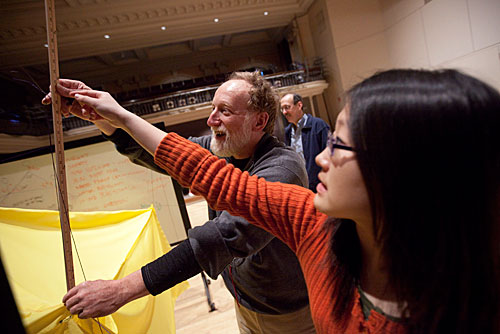
Man with balloons
Barry Griffin (left), with Cherry Park ’14, led undergrads on a winter break project to invent and construct a balloon-supported structure that could be used for lifting and/or shelter in the wake of disasters like last year’s earthquake in Haiti. Here, the prototypes are built.
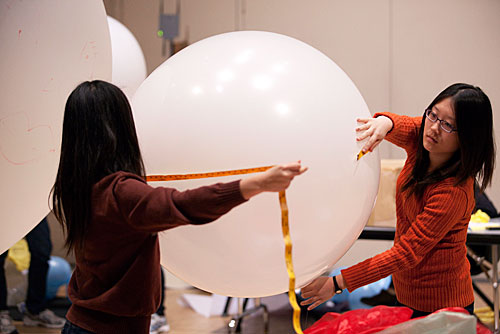
Global solutions
Jessica Wu ’14 (left) and Cherry Park ’14 work on their invention.
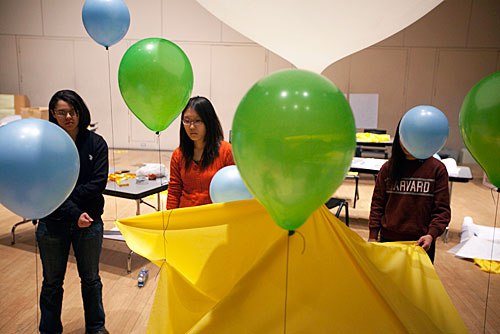
January. What break?
No, it’s not all fun and games. Danielle Ithier ’14 (from left), Jessica Wu ’14, and Cherry Park ’14 waived their holiday break to help develop a rapid deployment disaster relief shelter.
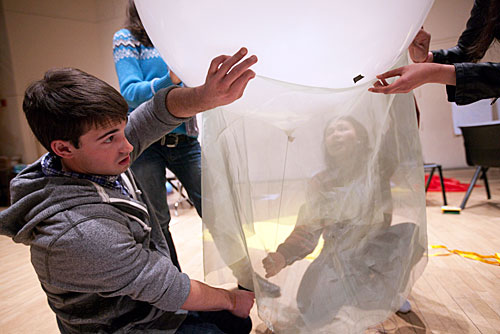
Working hard
Gary Carlson ’13 and Jia Jia Zhang ’13 work on a balloon prototype over their winter break.
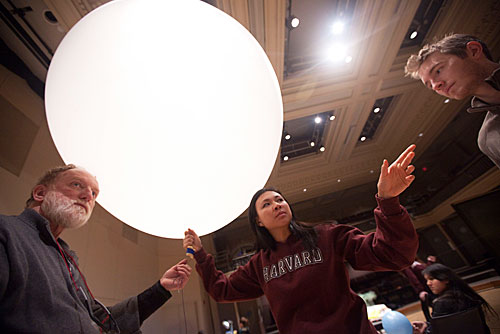
In flight
Barry Griffin (left), with students, prepares to test the prototype.
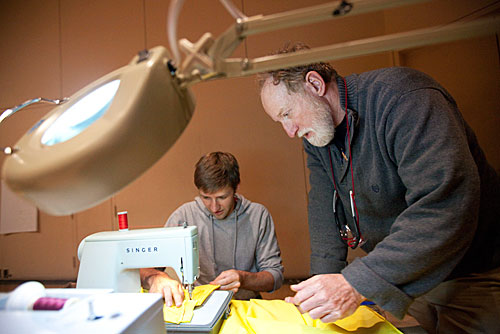
Sew what
“It occurred to me that we might be able to combine some ideas from balloon logging with some things that Dan Nevius ’11 (at machine), Julie Xie ’12, and several other students were doing as part of the NASA Student Engineering Design Challenge,” said Barry Griffin.
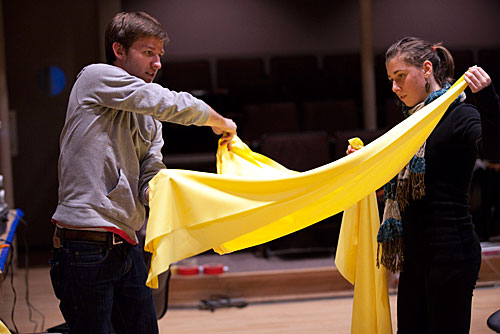
Working out the kinks
Dan Nevius ’11 gets a hand from pal Patricia Florescu ’11. Florescu, an applied math concentrator with a background in architecture, says she was inspired to cut her winter break short and return to campus for the RDDRS project because of the ongoing problem with shelter in Haiti.

Lend a hand
Hands of the volunteers work together to tie the prototype.
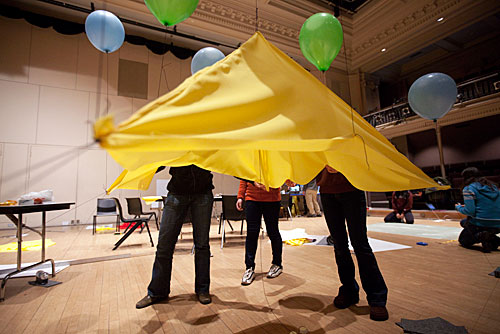
Tent of dreams
Much of the work for the project takes place in Lowell Lecture Hall, where students design, sew, rig, and suspend small fabric models from 3-foot-diameter weather balloons. The plan is to evaluate the different models, choose the most promising one, and erect a prototype on the Harvard campus in the near future.
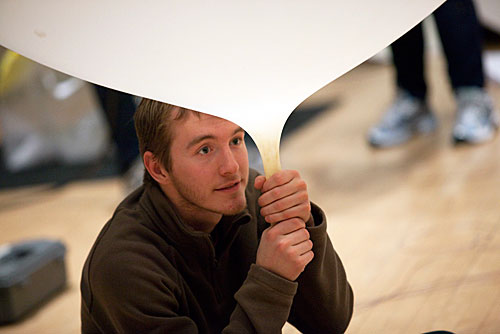
Oxygenated
Will Burke ’13 holds the balloon tight.
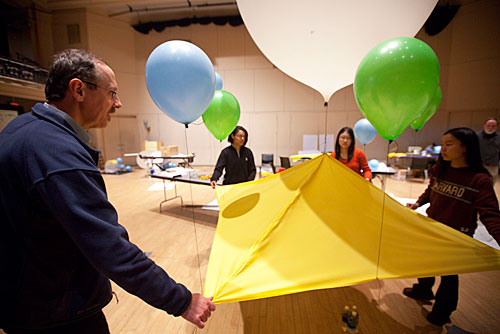
Why not?
Barry Griffin, a visiting lecturer at SEAS, says that images of the Haiti earthquake’s aftermath got him thinking of some work he’d done using balloons to move logs in West Coast forests. If a balloon could lift a tree, then why not a tent? Why not debris?

Wintry mix
Days after the blizzard, Gary Carlson ’13 (left) and Barry Griffin take the balloon outdoors for some testing in Cambridge’s own disaster zone.





